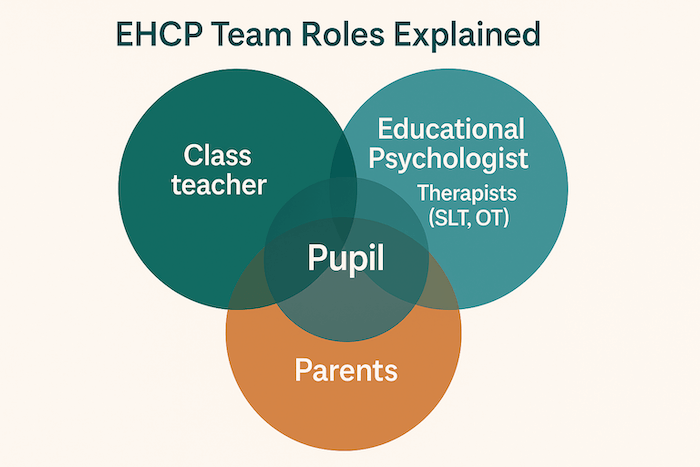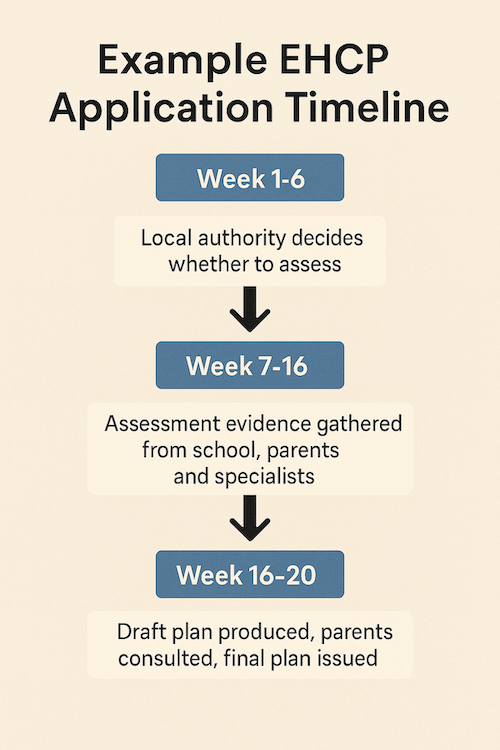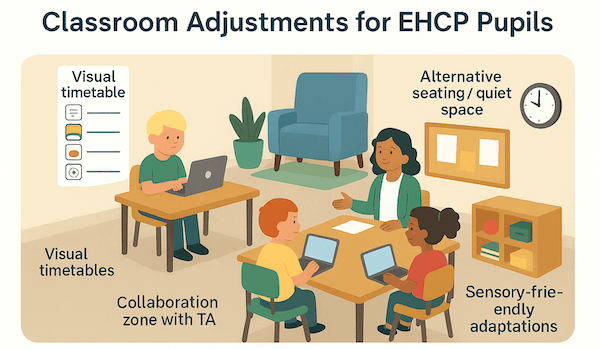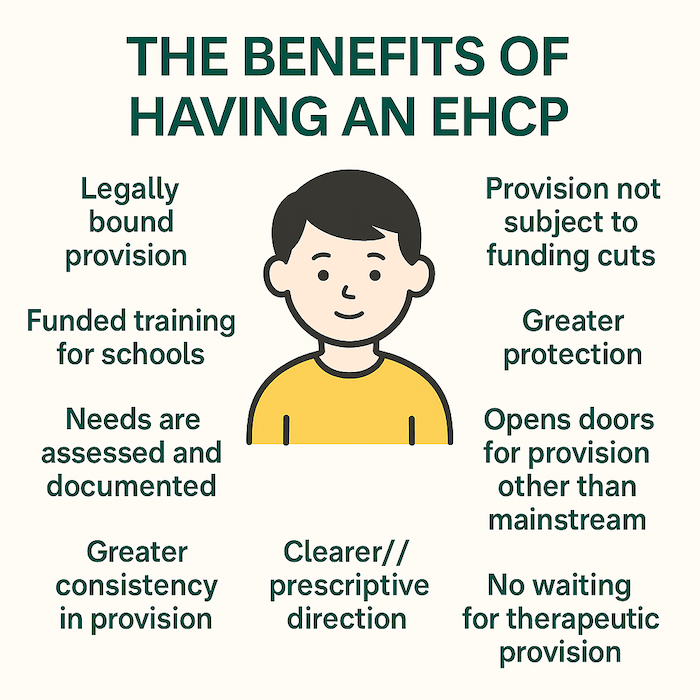The 2025 Guide to EHCPs
Understand Education, Health and Care Plans in 2025. Practical guidance for teachers on EHCP processes, legal duties, and classroom strategies for supporting SEND pupils.


An Education, Health and Care Plan is a legally binding document for children and young people aged 0 to 25 with special educational needs and disabilities. It replaces the old system of statements and learning difficulty assessments that existed before the SEND Code of Practice reforms in 2014.
The plan brings together education, health, and social care needs in one place through a multi-disciplinary assessment process. It specifies the outcomes a child should achieve, the support required to reach those outcomes, and who will provide that support. You'll find detailed information about provision, placement, and funding within this binding document.
EHCPs differ from SEN Support in scope and legal weight. While SEN Support can be managed within school using existing resources, an EHCP means the local authority must arrange and fund the specified provision. This legal guarantee ensures qualified staff and resources are allocated to meet the child's learning needs.

Not every child with SEND needs an EHCP. The threshold is high.
A child might need an EHCP if their needs can't be met through the resources normally available to schools, including those available for Quality First Teaching. The local authority considers whether the child needs provision beyond what's ordinarily available, and whether they require support across education, health, and social care sectors.
You might request an assessment for a pupil who shows persistent difficulties despite targeted interventions through differentiation strategies and additional support. Examples include children with severe learning difficulties, complex medical needs, or significant sensory impairments. The key question is whether school-based SEN Support has been tried and hasn't worked.
Parents, schools, or young people themselves can submit a request letter asking for an EHCP needs assessment. This request letter can be sent by email or post to the local authority. The authority then has six weeks to decide whether to assess, and 20 weeks from the decision to issue a final plan if appropriate. Understanding these statutory deadlines helps you plan effectively for pupils awaiting assessment.

The EHCP application timeline follows strict regulations. Once a request is made, the local authority has six weeks to decide whether to proceed with assessment. If they agree, the full process must complete within 20 weeks.
During this period, various professionals contribute to the multi-disciplinary assessment. This might include educational psychologists, speech and language therapists, occupational therapists, medical professionals, and health visitors for younger children. Each professional provides advice from professionals that feeds into the final plan.
Week 1-6: Local authority decides whether to assess Week 7-16: Assessment evidence gathered from school, parents, and specialists Week 16-20: Draft plan produced, parents consulted, final plan issued
However, many local authorities struggle to meet these key deadlines. You might find the process takes considerably longer in practice. This delay can be frustrating when you're supporting a pupil who clearly needs additional resources now.

Teachers provide evidence that shapes the EHCP. You're often the professional who knows the child's learning patterns best.
During the assessment phase, you'll submit written evidence about the child's learning needs, the interventions you've tried, and their impact. Be specific. Instead of writing "Tom struggles with reading," write "Tom is working at a Year 2 level in Year 5. He requires daily phonics intervention and access to audio texts. Without this, he becomes anxious and disengaged."
You'll work with the SENCO to gather robust evidence. This might include assessment scores, work samples, observations, and feedback from teaching assistants. The local authority's educational psychologists often visit to observe the child in your classroom and discuss their needs with you. They conduct specialist assessments that inform the final plan.
Once an EHCP is in place, you implement the specified provision. This might mean allowing extra time for tasks, providing specific equipment through assistive technology, or working with external specialists who visit the school. The plan should clearly state what you need to do, how often, and with what resources.
Your teaching needs to focus on measurable goals and long-term outcomes specified in the plan. Avoid vague approaches. Track progress systematically so you can demonstrate impact during annual reviews.
EHCPs follow a structured format with lettered sections. Each section serves a specific legal purpose.
Section A covers views of the child and family. You'll see quotes from the pupil about what helps them learn, as well as carers views about what they believe their child needs. This matters because provision should align with what the child finds useful, not just what adults think they need.
Sections B and C describe needs (B) and provision (C). Section B outlines the child's special educational needs in detail, including additional learning requirements. Section C specifies the support required, including staffing, resources, and strategies. These two sections must match. If Section B identifies difficulty with working memory, Section C should detail how to support working memory in practice through concrete actionable steps.
Sections D and E cover health needs (D) and health provision (E). Sections F and G address social care. You'll refer to these when coordinating with therapists or social worker colleagues who support the family.
Section I names the educational placement. This could be a mainstream school, special school, or other setting. Parents can express a preferred school, and the local authority must name that school unless it would be unsuitable for the child's needs, incompatible with efficient education of other children, or an inefficient use of resources. When a mainstream setting is named, you need to understand what additional support will be provided to make placement work.
Section J covers personal budgets if the family chooses this option.

Annual reviews happen every 12 months, or every six months for children under five. You prepare for these meetings by gathering evidence of progress against the specified outcomes.
Look at the measurable goals stated in the plan. For each outcome, collect data showing what the child has achieved. Use work samples, assessment results, and observations from your mainstream classroom or specialist setting. Be honest about what's working and what isn't. Document school progress systematically throughout the year.
The review meeting includes parents, the child (where appropriate), the SENCO, and any professionals involved in the child's support. Care professionals such as therapists, medical professionals, educational psychologists, or social worker colleagues attend when needed. The meeting ensures ongoing liaison between all parties supporting the child.
You contribute by explaining what's happened in the classroom, highlighting progress, and identifying any barriers to learning. Bring examples of work. Show what the pupil can do now that they couldn't do a year ago.
The meeting considers whether the plan should continue, be amended, or cease. Most plans continue with amendments. You might recommend changes to provision if current strategies aren't effective, or if the child's needs have changed. Be prepared to discuss whether goals were realistic or whether vague outcomes made progress hard to measure.
After the meeting, the SENCO submits paperwork to the local authority. The local authority then decides whether to amend the plan. This process can take up to 12 weeks. Plan ahead for future reviews by maintaining good records throughout the year.
You don't need to reinvent your practice. Small adjustments often make a significant difference in your mainstream classroom.
Start with your classroom environment. Many EHCP pupils benefit from visual timetables, clear routines, and predictable structures. Consider where the child sits. Some pupils need a quiet workspace away from distractions. Others work better when seated near peers who model good learning behaviours and positive behavior strategies.
Use the provision specified in Section C. If the plan states "access to a laptop for recording work," don't assume the child should write by hand because "everyone else does." The EHCP exists because standard approaches don't work for this child. Honor the legal guarantee of support outlined in the plan.
Collaborate with qualified staff including teaching assistants. If the plan allocates TA support, clarify roles. The TA shouldn't just sit next to the child. Better approaches include pre-teaching vocabulary, scaffolding tasks, or facilitating peer work. The child needs to develop independence, not dependency.
Work with care professionals who visit your classroom. Speech therapists might model specific techniques. Occupational therapists can advise on sensory strategies or motor skills support. Educational psychologists offer insights into cognitive profiles and learning approaches that work.
Communicate with parents about day realities. They know their child better than anyone. Share what's working in class and ask what strategies work at home. This builds consistency across settings and helps parents understand school progress.

Let's address some myths about EHCPs.
Myth: "EHCPs are only for children with severe disabilities." Reality: Children with a range of needs might have EHCPs. The criterion is whether they need provision beyond what's ordinarily available in a mainstream setting, not the label attached to their difficulty.
Myth: "Once a child has an EHCP, they'll have it forever." Reality: Plans can cease if needs reduce or if the young person no longer requires the specified provision. This often happens when pupils make strong progress and no longer need support beyond what's ordinarily available.
Myth: "EHCPs guarantee one-to-one support with qualified staff." Reality: Section C specifies the provision needed. This might include TA support, but not necessarily one-to-one for all lessons. The plan should promote independence, not create dependency. Beware of unrealistic provision requests that aren't evidenced by need.
Myth: "Teachers aren't responsible for EHCP pupils; that's the SENCO's job." Reality: The class teacher is responsible for all pupils' learning, including those with EHCPs. The SENCO coordinates support and ongoing liaison with care professionals, but you deliver the teaching using effective teaching strategies.
Myth: "The daunting process of EHCP management is too complex for busy teachers." Reality: Once you understand the structure and your role, managing EHCP provision becomes part of your normal planning cycle. Break the complex task into smaller steps.
Schools must admit a child if they're named in Section I of the EHCP as the preferred school. You can't refuse placement because you feel the school can't meet the needs. The local authority must provide resources to deliver the specified provision. This legal guarantee protects the child's rights.
You have a legal duty to use your best endeavours to secure the special educational provision the child needs. This is defined in the Children and Families Act 2014. "Best endeavours" means making reasonable adjustments and using expertise and resources to meet needs, including accessing SEND training when necessary.
If you believe the provision in the plan isn't sufficient, raise this with your SENCO. They can request an interim or emergency review. Don't struggle in silence. The EHCP should be a working document that adapts to the child's changing needs. Collect additional evidence to support your concerns.
Ofsted inspectors look at how schools support pupils with SEND. They check whether EHCPs are implemented, whether pupils make progress, and whether provision is monitored and reviewed. Your records matter. Keep systematic notes showing how you've addressed learning needs and tracked progress toward long-term outcomes.
Many EHCP pupils receive support from specialists outside school. This multi-disciplinary assessment approach continues throughout the life of the plan.
Speech and language therapists might visit to work directly with the child or to train you in specific techniques. Occupational therapists assess and recommend adjustments for sensory needs or motor skills difficulties. Educational psychologists offer consultation and assessment. Medical professionals monitor health conditions. Health visitors support younger children and their families. Social worker colleagues coordinate support for families facing additional challenges.
Plan time to meet these care professionals. Ask them to model strategies. Request written guidance you can refer to later in your mainstream classroom. Don't assume you'll remember everything from a 20-minute conversation. Take notes on advice from professionals and file them with the EHCP.
Some pupils have health plans alongside their EHCP. This might cover medication, medical procedures, or emergency protocols. Understand your role in these plans. Know who to contact if concerns arise.
External professionals appreciate feedback. If a recommended strategy isn't working in your classroom context, explain why. They can adapt their advice or suggest alternatives. This ongoing liaison improves outcomes.

Transitions are high-risk points for EHCP pupils. Plan ahead to maintain continuity of support.
For transitions between year groups, ensure the receiving teacher reads the EHCP and understands the pupil's needs. Arrange a handover meeting. Share what's worked and what hasn't. Pass on resources and strategies that proved effective. Explain the day realities of supporting this pupil.
Moving to secondary school requires enhanced planning. The annual review in Year 5 or Year 6 should focus on preparation for transition. Visit the secondary school with the child. Share information early so the new school can prepare. Discuss whether the mainstream setting will continue to be appropriate or whether alternative educational placement should be considered.
Post-16 transitions bring different challenges. The EHCP can continue until age 25 if the young person remains in education or training. The focus shifts to preparing for adulthood outcomes, including employment, independent living, and community participation. Work on self-regulation skills becomes increasingly important.
Sometimes provision breaks down. A TA leaves and isn't replaced. Equipment doesn't arrive. Care professionals cancel sessions. Statutory deadlines are missed.
Document gaps in provision. Note dates, what should have happened, and what actually happened. Share concerns with your SENCO. They should notify the local authority that the legal guarantee outlined in the binding document isn't being honored.
Parents can complain to the local authority if provision isn't delivered. They can also appeal to the SEND tribunal about the content of the plan or the named preferred school. The tribunal process is stressful for families. Your accurate records help resolve disputes.
If you're asked to provide evidence for a tribunal, be factual. Describe what you've observed and what you've tried. Don't speculate about what might work in a different setting. Focus on the measurable goals that were or weren't achieved.

The SEND system faces significant pressure. Local authorities report rising demand for EHCPs alongside funding constraints.
Many areas struggle with assessment timelines. The 20-week statutory deadline within the EHCP application timeline is frequently missed. Schools wait months for assessments to start, then months more for final plans. This delay affects pupils who need support now, not in six months. The daunting process becomes even more challenging when key deadlines slip.
Recruiting specialist staff remains difficult. Schools report shortages of speech therapists, educational psychologists, and specialist teachers. When therapists carry huge caseloads, provision becomes reactive rather than preventative. Finding qualified staff to deliver specialized interventions is a complex task in many regions.
National SEND review recommendations published in recent years proposed changes to the system, including standardised national standards for EHCPs and improved accountability. Implementation varies by area. Stay informed about changes in your local authority regarding statutory deadlines, funding, and provision standards.

Talk to your SENCO. They're your first point of contact for EHCP questions and ongoing liaison with care professionals. Ask them about local authority processes, timelines, and support available in your school.
Read the SEND Code of Practice 2015. It's the statutory guidance governing EHCP processes. You don't need to memorise it, but understanding key sections helps you advocate for pupils and understand the legal guarantee they're entitled to.
Join networks of teachers working with SEND pupils. Organizations like Whole School SEND and nasen offer resources, training, and forums for sharing practice around supporting learning needs.
Consider how metacognitive strategies support EHCP pupils. Many children with SEND benefit from explicit teaching of learning strategies. The Structural Learning Thinking Framework provides practical tools for developing these skills in your mainstream classroom or specialist setting.
Research on EHCP effectiveness continues to develop. These papers offer insights into policy implementation and outcomes.
An Education, Health and Care Plan is a legally binding document for children and young people aged 0 to 25 with special educational needs and disabilities. It replaces the old system of statements and learning difficulty assessments that existed before the SEND Code of Practice reforms in 2014.
The plan brings together education, health, and social care needs in one place through a multi-disciplinary assessment process. It specifies the outcomes a child should achieve, the support required to reach those outcomes, and who will provide that support. You'll find detailed information about provision, placement, and funding within this binding document.
EHCPs differ from SEN Support in scope and legal weight. While SEN Support can be managed within school using existing resources, an EHCP means the local authority must arrange and fund the specified provision. This legal guarantee ensures qualified staff and resources are allocated to meet the child's learning needs.

Not every child with SEND needs an EHCP. The threshold is high.
A child might need an EHCP if their needs can't be met through the resources normally available to schools, including those available for Quality First Teaching. The local authority considers whether the child needs provision beyond what's ordinarily available, and whether they require support across education, health, and social care sectors.
You might request an assessment for a pupil who shows persistent difficulties despite targeted interventions through differentiation strategies and additional support. Examples include children with severe learning difficulties, complex medical needs, or significant sensory impairments. The key question is whether school-based SEN Support has been tried and hasn't worked.
Parents, schools, or young people themselves can submit a request letter asking for an EHCP needs assessment. This request letter can be sent by email or post to the local authority. The authority then has six weeks to decide whether to assess, and 20 weeks from the decision to issue a final plan if appropriate. Understanding these statutory deadlines helps you plan effectively for pupils awaiting assessment.

The EHCP application timeline follows strict regulations. Once a request is made, the local authority has six weeks to decide whether to proceed with assessment. If they agree, the full process must complete within 20 weeks.
During this period, various professionals contribute to the multi-disciplinary assessment. This might include educational psychologists, speech and language therapists, occupational therapists, medical professionals, and health visitors for younger children. Each professional provides advice from professionals that feeds into the final plan.
Week 1-6: Local authority decides whether to assess Week 7-16: Assessment evidence gathered from school, parents, and specialists Week 16-20: Draft plan produced, parents consulted, final plan issued
However, many local authorities struggle to meet these key deadlines. You might find the process takes considerably longer in practice. This delay can be frustrating when you're supporting a pupil who clearly needs additional resources now.

Teachers provide evidence that shapes the EHCP. You're often the professional who knows the child's learning patterns best.
During the assessment phase, you'll submit written evidence about the child's learning needs, the interventions you've tried, and their impact. Be specific. Instead of writing "Tom struggles with reading," write "Tom is working at a Year 2 level in Year 5. He requires daily phonics intervention and access to audio texts. Without this, he becomes anxious and disengaged."
You'll work with the SENCO to gather robust evidence. This might include assessment scores, work samples, observations, and feedback from teaching assistants. The local authority's educational psychologists often visit to observe the child in your classroom and discuss their needs with you. They conduct specialist assessments that inform the final plan.
Once an EHCP is in place, you implement the specified provision. This might mean allowing extra time for tasks, providing specific equipment through assistive technology, or working with external specialists who visit the school. The plan should clearly state what you need to do, how often, and with what resources.
Your teaching needs to focus on measurable goals and long-term outcomes specified in the plan. Avoid vague approaches. Track progress systematically so you can demonstrate impact during annual reviews.
EHCPs follow a structured format with lettered sections. Each section serves a specific legal purpose.
Section A covers views of the child and family. You'll see quotes from the pupil about what helps them learn, as well as carers views about what they believe their child needs. This matters because provision should align with what the child finds useful, not just what adults think they need.
Sections B and C describe needs (B) and provision (C). Section B outlines the child's special educational needs in detail, including additional learning requirements. Section C specifies the support required, including staffing, resources, and strategies. These two sections must match. If Section B identifies difficulty with working memory, Section C should detail how to support working memory in practice through concrete actionable steps.
Sections D and E cover health needs (D) and health provision (E). Sections F and G address social care. You'll refer to these when coordinating with therapists or social worker colleagues who support the family.
Section I names the educational placement. This could be a mainstream school, special school, or other setting. Parents can express a preferred school, and the local authority must name that school unless it would be unsuitable for the child's needs, incompatible with efficient education of other children, or an inefficient use of resources. When a mainstream setting is named, you need to understand what additional support will be provided to make placement work.
Section J covers personal budgets if the family chooses this option.

Annual reviews happen every 12 months, or every six months for children under five. You prepare for these meetings by gathering evidence of progress against the specified outcomes.
Look at the measurable goals stated in the plan. For each outcome, collect data showing what the child has achieved. Use work samples, assessment results, and observations from your mainstream classroom or specialist setting. Be honest about what's working and what isn't. Document school progress systematically throughout the year.
The review meeting includes parents, the child (where appropriate), the SENCO, and any professionals involved in the child's support. Care professionals such as therapists, medical professionals, educational psychologists, or social worker colleagues attend when needed. The meeting ensures ongoing liaison between all parties supporting the child.
You contribute by explaining what's happened in the classroom, highlighting progress, and identifying any barriers to learning. Bring examples of work. Show what the pupil can do now that they couldn't do a year ago.
The meeting considers whether the plan should continue, be amended, or cease. Most plans continue with amendments. You might recommend changes to provision if current strategies aren't effective, or if the child's needs have changed. Be prepared to discuss whether goals were realistic or whether vague outcomes made progress hard to measure.
After the meeting, the SENCO submits paperwork to the local authority. The local authority then decides whether to amend the plan. This process can take up to 12 weeks. Plan ahead for future reviews by maintaining good records throughout the year.
You don't need to reinvent your practice. Small adjustments often make a significant difference in your mainstream classroom.
Start with your classroom environment. Many EHCP pupils benefit from visual timetables, clear routines, and predictable structures. Consider where the child sits. Some pupils need a quiet workspace away from distractions. Others work better when seated near peers who model good learning behaviours and positive behavior strategies.
Use the provision specified in Section C. If the plan states "access to a laptop for recording work," don't assume the child should write by hand because "everyone else does." The EHCP exists because standard approaches don't work for this child. Honor the legal guarantee of support outlined in the plan.
Collaborate with qualified staff including teaching assistants. If the plan allocates TA support, clarify roles. The TA shouldn't just sit next to the child. Better approaches include pre-teaching vocabulary, scaffolding tasks, or facilitating peer work. The child needs to develop independence, not dependency.
Work with care professionals who visit your classroom. Speech therapists might model specific techniques. Occupational therapists can advise on sensory strategies or motor skills support. Educational psychologists offer insights into cognitive profiles and learning approaches that work.
Communicate with parents about day realities. They know their child better than anyone. Share what's working in class and ask what strategies work at home. This builds consistency across settings and helps parents understand school progress.

Let's address some myths about EHCPs.
Myth: "EHCPs are only for children with severe disabilities." Reality: Children with a range of needs might have EHCPs. The criterion is whether they need provision beyond what's ordinarily available in a mainstream setting, not the label attached to their difficulty.
Myth: "Once a child has an EHCP, they'll have it forever." Reality: Plans can cease if needs reduce or if the young person no longer requires the specified provision. This often happens when pupils make strong progress and no longer need support beyond what's ordinarily available.
Myth: "EHCPs guarantee one-to-one support with qualified staff." Reality: Section C specifies the provision needed. This might include TA support, but not necessarily one-to-one for all lessons. The plan should promote independence, not create dependency. Beware of unrealistic provision requests that aren't evidenced by need.
Myth: "Teachers aren't responsible for EHCP pupils; that's the SENCO's job." Reality: The class teacher is responsible for all pupils' learning, including those with EHCPs. The SENCO coordinates support and ongoing liaison with care professionals, but you deliver the teaching using effective teaching strategies.
Myth: "The daunting process of EHCP management is too complex for busy teachers." Reality: Once you understand the structure and your role, managing EHCP provision becomes part of your normal planning cycle. Break the complex task into smaller steps.
Schools must admit a child if they're named in Section I of the EHCP as the preferred school. You can't refuse placement because you feel the school can't meet the needs. The local authority must provide resources to deliver the specified provision. This legal guarantee protects the child's rights.
You have a legal duty to use your best endeavours to secure the special educational provision the child needs. This is defined in the Children and Families Act 2014. "Best endeavours" means making reasonable adjustments and using expertise and resources to meet needs, including accessing SEND training when necessary.
If you believe the provision in the plan isn't sufficient, raise this with your SENCO. They can request an interim or emergency review. Don't struggle in silence. The EHCP should be a working document that adapts to the child's changing needs. Collect additional evidence to support your concerns.
Ofsted inspectors look at how schools support pupils with SEND. They check whether EHCPs are implemented, whether pupils make progress, and whether provision is monitored and reviewed. Your records matter. Keep systematic notes showing how you've addressed learning needs and tracked progress toward long-term outcomes.
Many EHCP pupils receive support from specialists outside school. This multi-disciplinary assessment approach continues throughout the life of the plan.
Speech and language therapists might visit to work directly with the child or to train you in specific techniques. Occupational therapists assess and recommend adjustments for sensory needs or motor skills difficulties. Educational psychologists offer consultation and assessment. Medical professionals monitor health conditions. Health visitors support younger children and their families. Social worker colleagues coordinate support for families facing additional challenges.
Plan time to meet these care professionals. Ask them to model strategies. Request written guidance you can refer to later in your mainstream classroom. Don't assume you'll remember everything from a 20-minute conversation. Take notes on advice from professionals and file them with the EHCP.
Some pupils have health plans alongside their EHCP. This might cover medication, medical procedures, or emergency protocols. Understand your role in these plans. Know who to contact if concerns arise.
External professionals appreciate feedback. If a recommended strategy isn't working in your classroom context, explain why. They can adapt their advice or suggest alternatives. This ongoing liaison improves outcomes.

Transitions are high-risk points for EHCP pupils. Plan ahead to maintain continuity of support.
For transitions between year groups, ensure the receiving teacher reads the EHCP and understands the pupil's needs. Arrange a handover meeting. Share what's worked and what hasn't. Pass on resources and strategies that proved effective. Explain the day realities of supporting this pupil.
Moving to secondary school requires enhanced planning. The annual review in Year 5 or Year 6 should focus on preparation for transition. Visit the secondary school with the child. Share information early so the new school can prepare. Discuss whether the mainstream setting will continue to be appropriate or whether alternative educational placement should be considered.
Post-16 transitions bring different challenges. The EHCP can continue until age 25 if the young person remains in education or training. The focus shifts to preparing for adulthood outcomes, including employment, independent living, and community participation. Work on self-regulation skills becomes increasingly important.
Sometimes provision breaks down. A TA leaves and isn't replaced. Equipment doesn't arrive. Care professionals cancel sessions. Statutory deadlines are missed.
Document gaps in provision. Note dates, what should have happened, and what actually happened. Share concerns with your SENCO. They should notify the local authority that the legal guarantee outlined in the binding document isn't being honored.
Parents can complain to the local authority if provision isn't delivered. They can also appeal to the SEND tribunal about the content of the plan or the named preferred school. The tribunal process is stressful for families. Your accurate records help resolve disputes.
If you're asked to provide evidence for a tribunal, be factual. Describe what you've observed and what you've tried. Don't speculate about what might work in a different setting. Focus on the measurable goals that were or weren't achieved.

The SEND system faces significant pressure. Local authorities report rising demand for EHCPs alongside funding constraints.
Many areas struggle with assessment timelines. The 20-week statutory deadline within the EHCP application timeline is frequently missed. Schools wait months for assessments to start, then months more for final plans. This delay affects pupils who need support now, not in six months. The daunting process becomes even more challenging when key deadlines slip.
Recruiting specialist staff remains difficult. Schools report shortages of speech therapists, educational psychologists, and specialist teachers. When therapists carry huge caseloads, provision becomes reactive rather than preventative. Finding qualified staff to deliver specialized interventions is a complex task in many regions.
National SEND review recommendations published in recent years proposed changes to the system, including standardised national standards for EHCPs and improved accountability. Implementation varies by area. Stay informed about changes in your local authority regarding statutory deadlines, funding, and provision standards.

Talk to your SENCO. They're your first point of contact for EHCP questions and ongoing liaison with care professionals. Ask them about local authority processes, timelines, and support available in your school.
Read the SEND Code of Practice 2015. It's the statutory guidance governing EHCP processes. You don't need to memorise it, but understanding key sections helps you advocate for pupils and understand the legal guarantee they're entitled to.
Join networks of teachers working with SEND pupils. Organizations like Whole School SEND and nasen offer resources, training, and forums for sharing practice around supporting learning needs.
Consider how metacognitive strategies support EHCP pupils. Many children with SEND benefit from explicit teaching of learning strategies. The Structural Learning Thinking Framework provides practical tools for developing these skills in your mainstream classroom or specialist setting.
Research on EHCP effectiveness continues to develop. These papers offer insights into policy implementation and outcomes.